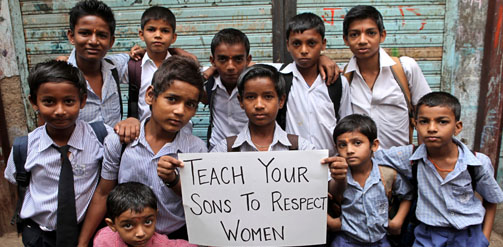30 March 2015
Gender justice is not just
a fight for women, by women: a clear message from the 59th United
Nations Commission on the Status of Women (CSW59) which took place 9-20
March 2015 in New York.

The event marked 20 years since the 1995 Beijing Fourth World Conference on Women and its landmark Platform for Action.
The role of men and boys was a hot topic at CSW59, with many side events on the topic full to bursting point, and a dedicated discussion in the main session.
Joni van de Sand, Global Co-coordinator and Advocacy Manager of the MenEngage alliance attended her fifth CSW this year and said she had seen a significant change in how work with men and boys was discussed. 'I think it is an example of the discourse around gender equality shifts over the years. If this is possible the other things are possible as well,' she said.
The focus on men and boys has become part of mainstream gender equality discourse, partly thanks to UN Women’s He For She campaign, backed by celebrity endorsements such as actress Emma Watson. Over 270,700 men around the world have signed up to 'take action against all forms of violence and discrimination faced by women and girls.'
But, some feel that these type of campaigns can play into a patriarchal approach, for example seeing men as the protectors of women and challenging them to be a ‘real man’, or encouraging a one off signature of attending an event instead of long term transformative change.
'That kind of backfired a little bit because it was like, okay UN Women launch its first big campaign and it’s about men,' explained van de Sand. 'But at the same time, maybe that helped to open up the discussion.'
The momentum behind work with men and boys was also boosted by the International Conference on Masculinities: Engaging Men and Boys for Gender Equality, hosted by the Center for the Study of Men and Masculinities in New York from 5-8 March.
While there is an increasing amount of gender equality work focused on engaging men and boys, including work with perpetrators of violence or encouraging men to take more active roles in care work, health or family life, the evidence base remains small.
To address this gap, a consortium of the Institute of Development Studies (IDS), Promundo-US and Sonke Gender Justice Network now collaborates in ‘Engendering Men: Evidence on Routes to Gender Equality’ (EMERGE), a two-year project to build an openly accessible basis of evidence, lessons and guidance for working with boys and men to promote gender equality.
During one CSW59 side event, Michael Flood, senior lecturer at the University of Wollongong (and Expert Advisory Group member of EMERGE) said that, from the research, the more effective interventions involving men and boys are gender transformative – they explicitly address and aim to transform ideals and practices associated with masculinity and gender.
Many organisations talking about their work with men and boys at CSW59 said that although they were cautious about taking on the work at first, they were asked to do it by the woman survivors of sexual and gender-based violence (SGBV) they worked with, some of whom did not want to leave their partners – they just wanted the violence to stop.
Despite its popularity as a point of discussion, there is a real concern that funding for work with men and boys could distract money from work with women and girls, especially as it becomes more fashionable. There are also many ways of interpreting how this work should be done.
'As MenEngage we’ve been really vocal in saying this can never ever be seen as the next silver bullet,' explained van de Sand. 'Engaging men and boys is not an end in itself.'
This was emphasised in the alliance’s oral statement, presented by van de Sand to CSW59 on 17 March which called for a scaling up of projects and for work with men and boys to be ‘institutionalised’ in policies and programmes.
The statement also emphasised the importance of working with women’s organisations. 'We reject attempts to weaken our alliances or to put complementary approaches in competition with one another. We call on policy makers and donors to dramatically increase the resources available for all gender justice work.'
Building on success at CSW59, van de Sand thinks the next step for the movement to engage men and boys is to build more connections throughout the year and focus on advocacy and holding national governments to account: 'There are 680 member organisations of MenEngage around the world – there’s an incredible potential there for stepping up as activists.'
The EMERGE Men, Boys and Gender Equality website is building an openly accessible collection of evidence and lessons for working with boys and men. Find out more at the EMERGE website.
The newly published Evidence Summary, ‘Engendering Men A Collaborative Review of Evidence on Men and Boys in Social Change and Gender Equality’ is available to download online for free.
source: https://www.ids.ac.uk/news/commission-on-the-status-of-women-steps-up-work-to-engage-men-and-boys


